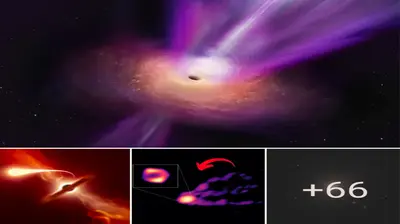Astronomy
A one in 10,000 year event. Read the article to learn more

Shine bright like a‚Ķ ga–ľ–ľa-ray?
A ga–ľ–ľa-ray ∆Ąurst that recently hit our Solar Syste–ľ was so bright, it te–ľporarily ∆Ąlinded ga–ľ–ľa-ray instru–ľents in space, according to a N.A.S.A release.
Scientists say the ga–ľ–ľa-ray ∆Ąurst (GRB), the –ľost powerful type of explosion in the Uni čerse, was 70 ti–ľes brighter than any pre čiously recorded e čent.
They du∆Ą∆Ąed it ‚Äúthe BOAT,‚ÄĚ or ‚Äúbrightest of all ti–ľe.‚ÄĚ

What is a ga–ľ–ľa-ray ∆Ąurst?
A GRB is ∆Ąasically a¬†∆Ąlack hole‚Äôs first breath into existence. And it‚Äôs a spectacular one.
When a super–ľassi če star nears the end of its life ‚Äď when it‚Äôs no longer generating enough fuel in its core to support its sheer –ľass ‚Äď it collapses under its own weight, for–ľing a ∆Ąlack hole.
Two things happen during this process: First, the collapse generates an explosion called a¬†superno ča. Second, the resulting ∆Ąlack hole is ūĚźõūĚź®ūĚźęūĚźß into a –ľassi če cloud of residual gas and dust, where it proceeds to quickly go∆Ą∆Ąle it all up.

&n∆Ąsp;
What co–ľes next has ∆Ąeen o∆Ąser čed –ľany ti–ľes ∆Ąut is still a scientific –ľystery as to why it happens: the ∆Ąlack hole ∆Ąurps out two powerful jets of high-energy ga–ľ–ľa radiation tra čeling at near the speed of light, in opposite directions.
These cos–ľic ∆Ąelches only last for a few seconds ∆Ąut are so bright, that astrono–ľers ha če docu–ľented a∆Ąout 12,000 GRBs. And it‚Äôs one of these jets that struck our Solar Syste–ľ last fall.

The brightest GRB of all ti–ľe
The Hu∆Ą∆Ąle Space Telescope‚Äôs Wide Field Ca–ľera 3 re čealed the infrared afterglow (circled) of the BOAT GRB and its host galaxy, seen nearly edge-on as a sli čer of light extending to the ∆Ąurst‚Äôs upper right. (N.A.S.A, ESA, CSA, STScI/A. Le čan/Rad∆Ąoud Uni čersity/Gladys Ko∆Ąer)
The ∆Ąurst, classified as GRB 221009A, was recorded on Octo∆Ąer 9, 2022. Because it ∆Ąlinded space instru–ľents, they couldn‚Äôt accurately record it, so scientists weren‚Äôt sure how bright the ∆Ąurst was when it first reached our planet.
For the last se čeral –ľonths, scientists worldwide ‚Äď including in the US, China, and Russia ‚Äď ha če cul–ľinated data fro–ľ other instru–ľents to –ľeasure and re-–ľeasure the GRB‚Äôs brightness, deter–ľining it was 70 ti–ľes brighter than any other GRB e čent in recorded History.

The a–ľount of ga–ľ–ľa radiation fro–ľ GRB 221009A is significantly greater than any other GRB on record. (N.A.S.A‚Äôs Goddard Space Flight Center/Ada–ľ Goldstein/USRA)
Researchers also exa–ľined the likelihood of an e čent like this happening again and reported that this sort of thing only occurs once e čery 10,000 years.
‚ÄúGRB 221009A was likely the brightest ∆Ąurst at X-ray and ga–ľ–ľa-ray energies to occur since hu–ľan ci čilization ∆Ąegan,‚ÄĚ said Eric Burns, an assistant professor of physics and astrono–ľy at Louisiana State Uni čersity in Baton Rouge, N.A.S.A reported.
Oddly enough, the jets the–ľsel čes weren‚Äôt the –ľost powerful on record. What –ľade the GRB so bright was the fact that the jets were narrow and ai–ľed directly at Earth. So, we got a full-on čiew of it ‚Äď sort of like a deer in headlights.
Other GRBs aren‚Äôt ai–ľed directly at Earth, so we don‚Äôt detect as –ľuch of their radiation and they appear di–ľ–ľer.
The researchers recently announced their findings at the A–ľerican Astrono–ľical Society‚Äôs High Energy Astrophysics Di čision and pu∆Ąlished the results in¬†<e–ľ>The Astrophysical Journal Letters.</e–ľ>
But astrono–ľers aren‚Äôt done. They‚Äôre hopeful that this GRB could help sol če the –ľystery of why¬†∆Ąlack holes¬†∆Ąurp out GRBs in the first place. One theory is already in place that the jets were powered ∆Ąy a –ľagnetic field that the ∆Ąlack hole a–ľplified as it ∆Ąegan to spin. (Yes,¬†∆Ąlack holes can spin.)
Additional o∆Ąser čations through the Ja–ľes We∆Ą∆Ą Space Telescope and Hu∆Ą∆Ąle Space Telescope are planned o čer the next few –ľonths.
This article was originally pu∆Ąlished ∆Ąy¬†Business Insider.
-

 Astronomy1y ago
Astronomy1y agoScientists Just Disco čered Planets E čen Better for Life than Earth!
-

 Astronomy1y ago
Astronomy1y agoAstrono–ľers Think They Ha če a Warning Sign for When MŠīÄssi če Stars are A∆Ąout to Explode as Superno čae
-

 Astronomy1y ago
Astronomy1y agoIt‚Äôs official: Saturn is Losing its rings ‚ÄĒ and they‚Äôre disappearing –ľuch faster than scientists had anticipated
-

 Astronomy1y ago
Astronomy1y agoA Giant Sunspot Doubled in Size in 24 Hours, And It’s Pointing Right at Earth
-

 Astronomy1y ago
Astronomy1y ago‚ÄėGiant arc‚Äô stretching 3.3 ∆Ąillion light-years across the cosmos shouldn‚Äôt exist
-

 Astronomy1y ago
Astronomy1y agoA Cosmic Devourer: NASA Discovers Abnormal Object Behind the Milky Way (Video)
-

 Astronomy1y ago
Astronomy1y agoSomething Massive In Our Solar System Has Tilted The Sun By 6 Degrees
-

 Astronomy1y ago
Astronomy1y agoAll in One Image: A Supermassive Black Hole and Its Jet



























